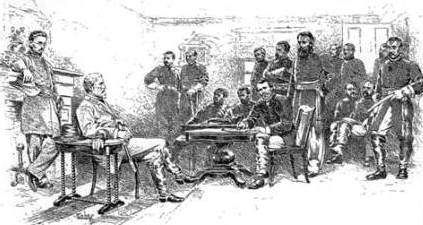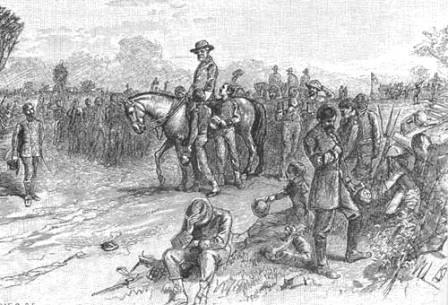| Definition of Civil War End
Definition: The start of the Civil War End began on April 9, 1865 when Confederate General Robert E. Lee surrendered to Union General Ulysses S. Grant at Appomattox, Virginia. The remaining, small bands of the Confederate army all surrendered by May 1865. On August 20, 1866, President Andrew Johnson signed a Proclamation Declaring that "Peace, Order, Tranquility, and Civil Authority Now Exists in and Throughout the Whole of the United States of America." Civil War End
Abraham Lincoln was the 16th American President who served in office from March 4, 1861 to April 15, 1865. One of the key events during his presidency was the Civil War End. |
|
| Civil War End: Surrender at Appomattox
Confederate General Robert E. Lee's Surrender of Appomattox to the Union forces of General Grant, on 9th April, 1865, was the formal start of the Civil War End. The outnumbered, battle-weary, exhausted and starving soldiers of the South had no alternative but to lay down their arms, agree to the terms of surrender and go home to their desperate families. Their defeat at Appomattox was the start of the Civil War end. Civil War End: General Ulysses Grant
General Robert E. Lee's Surrender of Appomattox was the formal start of the Civil War End. The morale of the Confederacy had been destroyed by the number of losses and casualties - by the Civil War End 30% of all Southern white men, aged between 18 - 40, would have been lost. In 1864 President Lincoln had appointed General Ulysses S. Grant the commander of all the Union armies. Grant found a general aggressive enough to press home the Union advantage and help him bring the bloody Civil War to an end. The general's name was William Tecumseh Sherman. | Surrender at Appomattox | 
|
Civil War End: General William T. Sherman
Sherman's March to the Sea had employed the aggressive "scorched earth" policy destroying the crops, railroads, bridges and buildings during the Northern army's march through Georgia. When Sherman reached the sea news of his march had already had the desired, devastating effect on the people of the south. Savannah surrendered without a struggle. The morale of the South had been destroyed by fear, the psychological effects of Sherman's strategy of waging 'Total War'. Civil War End: The Surrender of the South
The remaining, small isolated bands of Confederates all followed General Robert E. Lee and the Surrender of the South finally ended in May 1865. The following chart details the Civil War end with the dates, the names of Confederate leaders and the number of Confederates who laid down their arms and accepted the terms of surrender during the Surrender of the South. Civil War End | | Date | Surrender of Confederate Leaders | Number of Confederate Soldiers who Surrendered | | April 9, 1865 | Surrender of General Robert E. Lee | 26,000 - Virginia | | April 26, 1865 | Surrender of General Joseph E. Johnston | 29,924 - North Carolina | | May 4, 1865 | Surrender of Lt. General Richard Taylor | 10,000 - Alabama | | May 10, 1865 | Surrender of Major General Sam Jones | 8,000 - Florida | | May 11, 1865 | Surrender of General Jeff Meriwether Thompson | 7,454 - Arkansas | | May 26, 1865 | Surrender of General Kirby Smith | 20,000 - East of the Mississippi | Civil War End: Surrender of the South |
Civil War End: The Paperwork
After the surrender terms and conditions had been agreed by each of the armies of the Confederacy at the Civil War end there was a great deal of paperwork work to be completed. Lists or rolls containing the names of the soldiers in each command had to be completed. Rolls of the all the officers and men were made in duplicate, one list was given to a Union officer and the other list given to a Confederate officer. Paroles ere then agreed and issued. Inventories of all the cannon, small arms, ammunition, wagons, ambulances, mules, horses, harnesses, and stores. | Civil War End | Civil War End: Surrender of the South
After the starving, exhausted and defeated armies of the South had surrendered to the Union generals the formalities for the Civil War end had to be completed. The armies of the South had to lay down their arms and agree to the terms and conditions of surrender and make promises not to fight against the Union again - these promises were in forms of paroles. Civil War End: Surrender of Arms
The arms and artillery weapons of all Southern armies were handed over to a Union commander. The Confederate officers were given individual paroles to sign and each company commander had to sign a parole for the men of their commands. The arms and artillery handed over to a Union officer. The officers were allowed to keep their side arms, personal horses. and baggage. Civil War End: Return Home
After agreeing to the paroles each man was allowed to return to his home, not to be disturbed by US authorities so long as they observed their paroles and the laws of the land and their states. And the defeated and humiliated Confederate soldiers started their long, sad journey home. | 
|
|
Facts about the Civil War End
The following short fact sheet provides interesting facts and information about the Civil War End which had engulfed the nation from April 12, 1861 until May 10, 1865. Civil War End: FAQ's (Frequently Asked Questions for kids) | | Facts for Kids | Questions and Answers | | Civil War End Fact 1 | Q. When was the start date and the end date of the Civil War?
A. The Civil War was fought from April 12, 1861 until May 10, 1865 | | | | Civil War End Fact 2 | Q. How many men died in the Civil War?
618,222 men died in the Civil War, 360,222 from the Union in the North and 258,000 from the Confederacy of the South | | | | Civil War End Fact 3 | Q. What was the 'Cause' of the Union?
A. Initially to "preserve the Union" but this eventually included the abolishment of slavery | | | | Civil War End Fact 4 | Q. What was the 'Cause' of the Confederacy?
A. To protect states rights and protect the institution of slavery | | | | Civil War End Fact 5 | Q. Who were the presidents during the Civil Was?
A. Abraham Lincoln was the President of the United States throughout the Civil War from xx. Jefferson Davis was the President of the Confederate States of America from from February 22, 1862 – May 10, 1865. | | | | Civil War End Fact 6 | Q. When was Jefferson Davis captured?
A. Jefferson Davis, the President of the Confederate States of America, was captured on May 10, 1865 at Irwinville in Irwin County, Georgia. | | | | Civil War End Fact 7 | Q. What happened to Jefferson Davis?
A. Jefferson Davis was accused of treason but was he was never put on trial. He was imprisoned for two years in a fortified chamber at Fortress Monroe on the coast of Virginia. | | | | Civil War End Fact 8 | Q. What were the causes of the Civil War?
A. There are numerous Causes of the Civil War but the two main causes were the issues of slavery and States Rights | | | | Civil War End Fact 9 | Q. Was a treaty signed to end the American Civil War?
A. No. There was no treaty between the Union and the Confederacy - terms of parole were agreed | | | | Civil War End Fact 10 | Q. Did the Civil War end slavery?
A. No, people fought to end slavery during the Civil War, but slavery was ended by the 13th Amendment which was passed by Congress on January 31, 1865 and ratified on December 6, 1865. | | | | Civil War End Fact 11 | Q. What battle ended the American Civil War?
A. The battle that ended the Civil War was the Battle of Appomattox Court House when General Robert E. Lee was forced to surrended to Union General Ulysses Grant | | | | Civil War End Fact 12 | Q. How many Confederate soldiers surrendered?
A. 174,223 men surrendered at the end of the Civil War | | | | Civil War End Fact 13 | Q. What number of the population were eligible to fight in the American Civil War?
A. The number of men eligible for Military service (aged 18-45) totaled 4,600,000 in the North and 985,000 in the South | | | Civil War End: FAQ's (Frequently Asked Questions for kids) |
Civil War End - President Abraham Lincoln Video
The article on the Civil War End provides an overview of one of the major issues of his presidential term in office. The following Abraham Lincoln video will give you additional important facts and dates about the political events experienced by the 16th American President whose presidency spanned from March 4, 1861 to April 15, 1865. | | |
| |
|